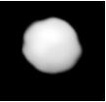Astronomy:145 Adeona
 | |
| Discovery[1] | |
|---|---|
| Discovered by | Christian Heinrich Friedrich Peters |
| Discovery date | 3 June 1875 |
| Designations | |
| (145) Adeona | |
| Pronunciation | /ædiːˈoʊnə/[4] |
| Named after | Adeōna[2] |
| Minor planet category | main-belt[3] · Adeona |
| Adjectives | Adeonian |
| Orbital characteristics[5][3] | |
| Epoch 31 July 2016 (JD 2457600.5) | |
| Uncertainty parameter 0 | |
| Observation arc | 130.60 yr (47700 d) |
| |{{{apsis}}}|helion}} | 3.05972 astronomical unit|AU (457.728 Gm) |
| |{{{apsis}}}|helion}} | 2.28737 AU (342.186 Gm) |
| 2.67354 AU (399.956 Gm) | |
| Eccentricity | 0.14444 |
| Orbital period | 4.37 yr (1596.7 d) |
| Mean anomaly | 233.709° |
| Mean motion | 0° 13m 31.663s / day |
| Inclination | 12.6337° |
| Longitude of ascending node | 77.4206° |
| 44.0233° | |
| Physical characteristics | |
| Dimensions | c/a = 0.92±0.03[6] |
| Mean diameter | 144±3 km[6] 151.14±3.2 km[3] 149.5±5.5 km[7] |
| Mass | (2.4±0.3)×1018 kg[6] (2.08±0.57)×1018 kg[7] |
| Mean density | 1.52±0.21 g/cm3[6] 1.18±0.34 g/cm3[7] |
Equatorial surface gravity | 0.0422 m/s2 |
Equatorial escape velocity | 0.0799 km/s |
| Rotation period | 15.071 h (0.6280 d) |
| Geometric albedo | 0.048 (calculated)[6] 0.0433±0.002[3] 0.0467 ± 0.0116[8] |
| C (Tholen)[8] | |
| Absolute magnitude (H) | 8.13,[3] 8.050[8] |
Adeona (minor planet designation: 145 Adeona) is a large asteroid from the intermediate asteroid belt, approximately 150 kilometers (93 miles) in diameter. Its surface is very dark,[8] and, based upon its classification as a C-type asteroid, is probably composed of primitive carbonaceous material. The spectra of the asteroid displays evidence of aqueous alteration.[9] The Adeona family of asteroids is named after it.
It was discovered by C. H. F. Peters on June 3, 1875, from the observatory at Hamilton College, Clinton, New York. Peters named it after Adeona, the Roman goddess of homecoming, because he had recently returned from a journey across the world to observe the transit of Venus. Peters also discovered 144 Vibilia on the same night.[10]
During 2001, Adeona was observed by radar from the Arecibo Observatory. The returned signal matched an effective diameter of 151 ± 18 km. This is consistent with the asteroid dimensions computed through other means.[11]
Two stellar occultations by Adeona have been observed: The first one on July 9, 2002 when it occulted an 11.8 mag star, and then again on February 3, 2005 when several observers in Japan recorded the occultation of a 10.4 mag star. The latter was consistent with a diameter of 151 km.[12][13][14]
The Dawn mission team discussed performing a flyby of this object, however NASA decided against it in July 2016.[15] At the time this was considered Dawn was orbiting the large asteroid/dwarf planet 1 Ceres, and went on studying that body later that year.[16] Dawn had previously orbited asteroid 4 Vesta, before traveling to Ceres.[16]
See also
- List of minor planets formerly targeted for spacecraft visitation
References
- ↑ "Discovery Circumstances: Numbered Minor Planets". http://cfa-www.harvard.edu/iau/lists/NumberedMPs.html.
- ↑ "Adeona in Lewis & Short". http://perseus.uchicago.edu/cgi-bin/philologic/getobject.pl?c.0:757.lewisandshort.
- ↑ 3.0 3.1 3.2 3.3 3.4 "145 Adeona". JPL Small-Body Database. NASA/Jet Propulsion Laboratory. https://ssd.jpl.nasa.gov/sbdb.cgi?sstr=145;cad=1.
- ↑ Noah Webster (1884) A Practical Dictionary of the English Language
- ↑ "The Asteroid Orbital Elements Database". Lowell Observatory. http://ftp.lowell.edu/pub/elgb/astorb.html.
- ↑ 6.0 6.1 6.2 6.3 6.4 P. Vernazza et al. (2021) VLT/SPHERE imaging survey of the largest main-belt asteroids: Final results and synthesis. Astronomy & Astrophysics 54, A56
- ↑ 7.0 7.1 7.2 Carry, B. (December 2012), "Density of asteroids", Planetary and Space Science 73 (1): 98–118, doi:10.1016/j.pss.2012.03.009, Bibcode: 2012P&SS...73...98C.
- ↑ 8.0 8.1 8.2 8.3 Pravec, P. et al. (May 2012), "Absolute Magnitudes of Asteroids and a Revision of Asteroid Albedo Estimates from WISE Thermal Observations", Asteroids, Comets, Meteors 2012, Proceedings of the conference held May 16–20, 2012 in Niigata, Japan 1667 (1667): pp. 6089, Bibcode: 2012LPICo1667.6089P.
- ↑ Fornasier, S. et al. (February 1999), "Spectroscopic comparison of aqueous altered asteroids with CM2 carbonaceous chondrite meteorites", Astronomy and Astrophysics Supplement 135: 65–73, doi:10.1051/aas:1999161, Bibcode: 1999A&AS..135...65F.
- ↑ Schmadel, Lutz D. (2003). Dictionary of Minor Planet Names. Springer Science & Business Media. p. 28. ISBN 978-3-540-00238-3. https://books.google.com/books?id=KWrB1jPCa8AC&pg=PA28.
- ↑ Magri, Christopher et al. (January 2007), "A radar survey of main-belt asteroids: Arecibo observations of 55 objects during 1999–2003", Icarus 186 (1): 126–151, doi:10.1016/j.icarus.2006.08.018, Bibcode: 2007Icar..186..126M
- ↑ "Observed minor planet occultation events". David Dunham. July 26, 2005. http://mpocc.astro.cz/world/mpocc1.txt. Retrieved June 3, 2017.
- ↑ "Results of Asteroidal occultation". Sendai Space Hall. http://sendaiuchukan.jp/data/occult-e/occult-e.html. Retrieved June 3, 2017.
- ↑ "Occultation of (145) Adeona on 2005.2.3". Sendai Space Hall. http://sendaiuchukan.jp/data/occult/0502adeona-red.gif. Retrieved June 3, 2017.
- ↑ "New Horizons Receives Mission Extension to Kuiper Belt, Dawn to Remain". July 2016. http://www.nasa.gov/feature/new-horizons-receives-mission-extension-to-kuiper-belt-dawn-to-remain-at-ceres.
- ↑ 16.0 16.1 Landau, Elizabeth (November 18, 2016). "New Ceres Views as Dawn Moves Higher". NASA / Jet Propulsion Laboratory. http://www.jpl.nasa.gov/news/news.php?feature=6678. Retrieved November 20, 2016.
External links
- 145 Adeona at AstDyS-2, Asteroids—Dynamic Site
- 145 Adeona at the JPL Small-Body Database
 |

